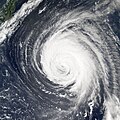ファイル:Ioke 2006-09-04 0320Z.jpg

このプレビューのサイズ: 600 × 600 ピクセル。 その他の解像度: 240 × 240 ピクセル | 480 × 480 ピクセル | 768 × 768 ピクセル | 1,024 × 1,024 ピクセル | 2,048 × 2,048 ピクセル | 7,500 × 7,500 ピクセル。
元のファイル (7,500 × 7,500 ピクセル、ファイルサイズ: 6.43メガバイト、MIME タイプ: image/jpeg)
ファイルの履歴
過去の版のファイルを表示するには、その版の日時をクリックしてください。
| 日付と時刻 | サムネイル | 寸法 | 利用者 | コメント | |
|---|---|---|---|---|---|
| 現在の版 | 2008年2月6日 (水) 20:47 |  | 7,500 × 7,500 (6.43メガバイト) | BetacommandBot | move approved by: User:ChristianBier This image was moved from Image:TS Ioke Sept 14 2006.jpg == Summary == {{Information |Description=Tropical Storm Ioke looks more like a worn-out typhoon than a tropical storm in satellite imagery obtained on |
ファイルの使用状況
このファイルを使用しているページはありません。
グローバルなファイル使用状況
以下に挙げる他のウィキがこの画像を使っています:
- es.wikipedia.org での使用状況


